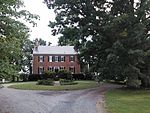The Tuleyries
Clarke County, Virginia geography stubsFederal architecture in VirginiaHistoric American Buildings Survey in VirginiaHouses completed in 1833Houses in Clarke County, Virginia ... and 4 more
Houses on the National Register of Historic Places in VirginiaNational Register of Historic Places in Clarke County, VirginiaPlantation houses in VirginiaShenandoah Valley, Virginia Registered Historic Place stubs

The Tuleyries is an ante-bellum estate near White Post, Virginia.
Excerpt from the Wikipedia article The Tuleyries (License: CC BY-SA 3.0, Authors, Images).The Tuleyries
Westfield Farm Lane,
Geographical coordinates (GPS) Address Nearby Places Show on map
Geographical coordinates (GPS)
| Latitude | Longitude |
|---|---|
| N 39.071111111111 ° | E -78.073888888889 ° |
Address
Westfield Farm Lane
Westfield Farm Lane
22620
Virginia, United States
Open on Google Maps










